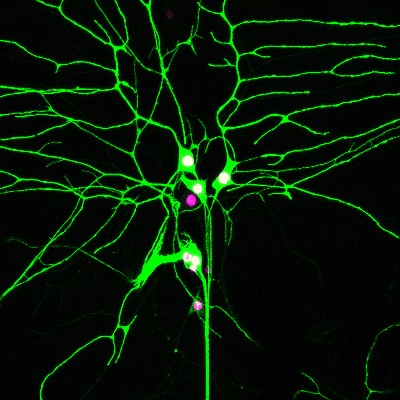New CRISPR technique for studying gene function developed
By Krishna Ramanujan
When researchers want to understand a gene’s function, they silence or disable that gene in a model organism, such as a fruit fly, and then look for unusual effects on the fly. This is referred to as creating loss-of-function, or “knocking out” a gene.
A study published in the February issue of the journal Genetics reports on a robust and efficient new method: using the gene-editing technology CRISPR-Cas9 for tissue-specific gene knockout. The technology allows researchers to manipulate gene functions in specific cell types without affecting other tissues, which is essential for characterizing gene function.
“In the past, different methods have been developed to try to achieve specific loss-of-function, and all of these previous methods have their own issues,” said Chun Han, the paper’s senior author and a Nancy M. and Samuel C. Fleming Assistant Professor in the Department of Molecular Biology and Genetics and the Weill Institute for Cell and Molecular Biology.
Amy Poe, a graduate student in Han’s lab, is the paper’s first author.
CRISPR-Cas9 employs a bacterial immune system known as CRISPR (clustered regularly-interspaced short palindromic repeats), which scientists have modified to edit genes. CRISPR systems are part of the bacteria’s natural defense primarily against bacterial viruses, called phages. When a phage infects a bacterium but doesn’t kill it, that bacterium takes a piece of that viral DNA and remembers it in the form of guide RNA.
RNA is the molecule used by all organisms to transmit genetic information from DNA to proteins, but in this case the RNA has been modified to serve as a guide that recognizes a sequence of viral DNA. When bacteria are reinfected by the same virus, the guide RNA directs CRISPR-associated (Cas) proteins to that precise string of viral DNA. Once located, these Cas proteins cut the viral DNA and disable the virus.
To knock out a gene, the researchers generated a strain of fruit flies that express a Cas9 protein in cells of a specific tissue. They also developed another line of flies that express in every cell guide RNAs targeted to a string of DNA of a specific gene. Afterward, they mated these two flies.
“When you bring these two components together in the same fly, they will knock out the gene only in the cells that express Cas9,” Han said.
Using CRISPR-Cas9 for this purpose solves problems researchers have faced. For example, one early technique created loss-of-function to an important gene, but it does so in every cell in the body, not just in specific tissues. In such cases, the manipulation can be too strong, causing the animal to die before any effects can be observed. Another common loss-of-function technique creates strong side effects. In other instances, when a researcher suspected that several genes worked together to generate a trait, there was no easy way to remove all the target genes at the same time.
“Now you can easily do that,” by making a transgene (a gene that is transferred naturally or by genetic engineering) that expresses multiple guide RNAs, Han said. “We can mutate three genes at the same time in the same cell.”
One drawback of CRISPR-Cas9 is that there is no way of knowing whether target genes carry their own pre-existing mutations. If they do, guide RNAs could miss their mark and the CRISPR-Cas9 loss-of-function may be incomplete, leading to inaccurate results. One fix to this issue could be to use at least two guide-RNAs, that target two or more sections of genetic code, to insure a gene is indeed knocked out.
The paper’s co-authors include a team of current and former members of Han’s lab, including undergraduate students.
The study was funded by Cornell and the National Institutes of Health.
Media Contact
Get Cornell news delivered right to your inbox.
Subscribe

